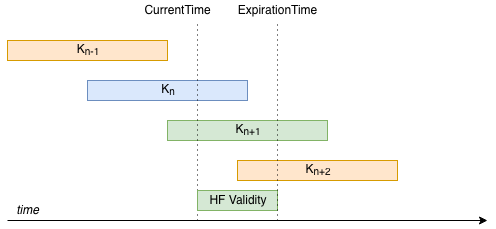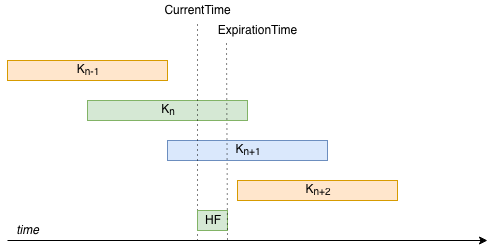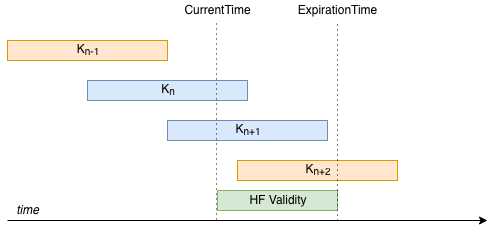Forwarding key rollover
Author: Sergiu Costea
Last updated: 2020-09-23
Status: WIP / Outdated
Discussion at: -
This document describes an implementation for key rollover in a SCION AS.
Because key rollover is an AS-local concept (the same AS does both MAC computation and verification), it is not a part of the SCION protocol. Every AS is free to implement these aspects however it sees fit, and this document presents one possible implementation.
Notation
ExpirationField: The value of the 1-byte HopField ExpTime field inserted
by the local beacon server. The linear scale as defined in the SCION book is
used. This is unknown, and must be computed by the beacon server during
beaconing (subject to AS policy).
MACField: The value of the 3-byte HopField MAC field inserted by the local
beacon server. This is unknown, and must be computed by the beacon server during
beaconing.
OriginationTime: The timestamp when a beacon is created. This is the timestamp
that is included in the Info Field of the segment. This is hardcoded in the
segment and cannot be changed.
ExpirationTime: The absolute point in time when the hop field expires. This is
defined as OriginationTime + (1 + ExpirationField) * 337s, where s refers to
seconds.
MasterKey: The key used to derive forwarding keys.
This document explains how, given OriginationTime, the CS should compute
ExpirationField and MACField to maximize the lifetime of the segment, in a
way that the border router can later successfully verify the MAC if and only if
it was created by the CS.
Design
Properties
Each key has two attributes:
NotValidBefore: the absolute time before which the key MUST NOT be used to compute or verify MACs;NotValidAfter: the absolute time after which the key MUST NOT be used to compute or verify MACs;
If at a point of reference the current time is greater or equal to
NotValidBefore and less than NotValidAfter, a key is said to be
valid.
Property 1: A constant number of keys must be valid at any time.
Let KeyLifetime be defined as NotValidAfter - NotValidBefore.
Property 2: KeyLifetime must be constant for all keys.
Property 3: A key rollover sequence is defined as a sequence of keys with the following constraints:
Properties 1 and 2 must hold
NotValidBeforevalues need to be monotonically increasing and equally spaced in time
The diagram below shows a well formed key rollover sequence of size 4, with 2
keys valid at the same time: K_n and K_(n+1).

For simplicity, for the rest of this document we assume the following sizes:
exactly 2 keys are valid at any time
the rollover sequences size is 4
OriginationTime is problematic because it is rarely decided by the local AS.
Depending on how beaconing happens upstream, OriginationTime can be so far in
the past that no forwarding key can be valid for the whole lifetime of the path.
However, assuming somewhat comparable clocks between CSes and routers, it is
irrelevant if the key is valid for any point in time prior to the moment when
the MAC is computed.
Refer to the diagram below. In this diagram, a CS must propagate an old beacon,
and must thus choose which of the two currently valid keys, K_n and K_(n+1),
to use for the computation of the MAC. The beacon is still valid, but its
OriginationTime is very far in the past, so far that no currently valid key is
valid for both. The question the CS must ask itself is: what is the remaining
lifetime of this path going to be, according to my security policy?
OriginationTime is irrelevant to the answer, which leads to the next property.

Property 4: OriginationTime must not be used directly for key selection;
ExpirationTime should be used instead.
If OriginationTime is not used by the CS when deciding to compute the MAC, it
also cannot be used by the router when verifying the MAC (note that it will be
used by the router when deciding if the HF is still within its predefined lifetime).
The CS must choose between K_n and K_(n+1). The only value it can publish about
its decision is the ExpirationTime (which it does via the ExpirationField in
the HF). The router will later need to decide which key to use based only on the
ExpirationTime; therefore, the choice must be unambiguous.
We remove the ambiguity by always choosing the key that is valid at
ExpirationTime and expires last. We showcase this with two examples.
In the diagram below, a beacon must be constructed, and at CurrentTime keys
K_n and K_(n+1) are valid. The CS wants to build a HF with a desired remaining
lifetime of half of KeyLifetime. Because K_n is not valid for the desired
remaining lifetime, K_(n+1) must be chosen.

In the diagram below, the CS wants to construct a HF with a much shorter
lifetime. Both keys are valid for the remaining lifetime. For the router to later
choose a key unambiguously, it must select K_n.

The router does the same computation to determine the key.
Property 5: Given the restrictions established in this section (exactly 2
keys valid), MAC computation is always done by selecting the key with the
smallest NotValidAfter value that is strictly greater than the desired
ExpirationTime (the strict here is important, because key lifetime is an open
interval on right).
There are situations where the desired remaining lifetime is impossible to satisfy. This might be always incompatible with key policy (the desired remaining lifetime is greater than key lifetime), or no valid key might exist at current time.
The latter situation is described in the diagram below. Desired remaining
lifetime is 3/4 of KeyLifetime. Thus, no valid key can be found.

To avoid this, we add the constraint that desired remaining lifetime be at
smaller or equal to 1/2 of KeyLifetime. If an AS wants paths to have maximum
lifetime while having constant remaining lifetime, then desired remaining
lifetime can be set to 1/2 KeyLifetime.
Implementing the CS
The CS needs to compute two values:
ExpirationFieldMACField
ExpirationField
The ExpirationField depends on the policy of desired remaining HF lifetime.
Taking into account Property 5, we select a constant desired remaining HF
lifetime of half of KeyLifetime.
Let DesiredRemainingLifetime be the time the HF is going to be valid for,
relative to current time. This is a value chosen by AS security policy; the
policy will usually specify a MaxRemainingLifetime, which is the upper bound
on acceptable DesiredRemainingLifetime.
We add the constraint that the HF MUST NOT be valid for longer than a
DesiredRemainingLifetime, but CAN be valid for less. This leads to a cleaner
intuition of the security offered by the parameter, where stricter is better.
ExpirationField is computed as follows:
ExpirationField = floor((CurrentTime - OriginationTime + DesiredRemainingLifetime) / 337s) - 1
If ExpirationField is negative, then the DesiredRemainingLifetime is too
short and not supported by the SCION protocol.
If ExpirationField is more than 255, then the DesiredRemainingLifetime is
too long and not supported by the SCION protocol for this specific beaconing attempt.
Because the value depends on CurrentTime, and can be the case that
the DesiredRemainingLifetime can be satisfied for only certain beacons.
Note that an increase of 1 in the value of ExpirationField leads to an
increase of 337 seconds in the lifetime of the HF. This means that the actual
remaining lifetime of the HF is an approximation of the initial
DesiredRemainingLifetime.
For CSes that originate the beacon, CurrentTime - OriginationTime SHOULD be 0.
MACField
First, the secret key needs to be computed from the MasterKey. The function we
recommend is:
Key = HKDF(pad128(2*ExpirationTime//KeyLifetime - 1) || MasterKey)
where pad128 is a left padding function to a bit-length of 128, || is the bit
concatenation operator, // is integer division with integer quotient, and
MasterKey is a shared secret of the AS. How to disseminate MasterKey is up
for discussion, with the solution of storing it in a file on-disk being the
simplest option for now. Other systems like
Vault might be useful in this scenario, if
storing it on disk is undesirable. MasterKey should be refreshed periodically
(e.g., once every 6 months).
Then, the MACField is computed as defined in the SCION protocol.
Implementing the router
When the router receives a path for processing, it must verify the HF. The first
step in this process is computing the MAC verification key. To compute the key,
first the ExpirationTime must be computed:
ExpirationTime = OriginationTime + (1 + ExpirationField) * 337s
If ExpirationTime < CurrentTime, the router SHOULD return an error stating as
such. If the check is successful, then the same function as in the CS can be
used to compute the key:
Key = HKDF(pad128(2*ExpirationTime//KeyLifetime - 1) || MasterKey)
If Key is not valid at CurrentTime, then HF verification MUST fail.
Fast key lookup
It is expensive to compute the Key for every MAC. A key rollover sequence
could be used instead. We show how a rollover sequence of size 2 can be used and
updated. Let KeyContext be this rollover sequence. The sequence has the
following fields:
Key0, the first valid key;Key1, the second valid key;ExpirationTimeKey0, the expiration time of the first key;ExpirationTimeKey1, the expiration time of the second key;
Let K_n be the sequence of forwarding keys, with n an integer value greater
or equal to 0. K_0 is active from moment 0 (beginning of unix time) to
KeyLifetime (excluding KeyLifetime, so open interval on KeyLifetime),
K_1 is active from KeyLifetime//2 to 3*KeyLifetime//2, and so on and so
forth. Key K_n is thus valid from n*KeyLifetime//2 to
(n+2)*KeyLifetime//2. Whenever a new key becomes valid, the following procedure runs:
set_new_key(NewKey, ExpTimeNewKey)
NewKeyCtx.Key0 = CurrentKeyCtx.Key1
NewKeyCtx.ExpirationTimeKey0 = CurrentKeyCtx.ExpirationTimeKey1
NewKeyCtx.Key1 = NewKey
NewKeyCtx.ExpirationTimeKey1 = ExpirationTimeNewKey
update_key_ctx(NewKeyCtx)
For each packet, the router must first compute the expiration time of the HF, similarly to the CS:
ExpirationTime = OriginationTime + (1 + ExpirationField) * 337s
get_key(ExpirationTime)
if ExpirationTime < CurrentKeyCtx.ExpirationTimeKey0
return CurrentKeyCtx.Key0
else
return CurrentKeyCtx.Key1
The key can then be used by the router to verify the MAC.
Recommended values
MaxDesiredRemainingLifetime: 3 days
KeyLifetime: 6 days
MasterKey bit length: 128 bits
Representation of pad(n) for HKDF: 128-bit unsigned int representation of n, in big endian
HKDF HMAC function: HMAC-SHA256
MasterKey lifetime: 6 months